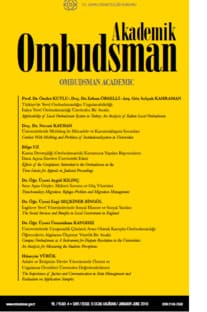AVRUPA BİRLİĞİ’NİN AVRUPA İNSAN HAKLARI SÖZLEŞMESİ’NE KATILIMI: SAATLER İLERİYE Mİ YOKSA GERİYE Mİ İŞLİYOR?
Bu makale, Avrupa Birliği Adalet Divanı’nın (ABAD) Avrupa Birliği’nin
(AB) Avrupa İnsan Hakları Sözleşmesi’ne (AİHS) katılımıyla ilgili Taslak
Anlaşma’ya ilişkin 18 Aralık 2014 tarihinde verdiği görüşün etkilerini
incelemektedir. 47 üye devleti olan Avrupa Konseyi ile AB temsilcilerinin
müzakere heyeti AB’nin AİHS’ye katılımıyla ilgili Taslak Anlaşma metni üzerinde
5 Nisan 2013 tarihinde mutabık kalmışlardır. 4 Temmuz 2013 tarihinde AB
Komisyonu Avrupa Birliği’nin İşleyişi Hakkındaki Antlaşma’nın (ABİHA) 218(11)
maddesi uyarınca Taslak Anlaşma’nın AB Antlaşması ile ABİHA’yla uyumlu olup
olmadığına dair görüş talebinde bulunmuştur.
18 Aralık 2014 tarihinde ABAD Taslak Anlaşma’nın AB hukukuna uygun
olmadığını belirten, zorlu şartlar ileri süren ve aşağıdaki çalışmada
irdelendiği üzere söz konusu katılımın gelecekte oldukça zor bir konu olduğunu
ortaya koyan nedenler ileri sürmüştür. Uzun bir süredir AB’nin insan haklarının
korunmasıyla ilgili dağınık yetkileri ile AB üye devletlerinin tümünün AİHS’ye
taraf olması ve fakat AB’nin AİHS’ye taraf olmamasıyla ilgili çelişki sürekli
tartışma konusu olmuştur. Bu makale, ABAD’ın AB’nin AİHS’ye katılımıyla ilgili
verdiği 2/13 sayılı görüşü; özellikle akademik camiada AB’nin AİHS’ye
katılımına ilişkin bilimsel tartışmaları, bu konudaki ABAD içtihadını ve Lizbon
Antlaşması’nın getirdiği değişiklikler yönünden çeşitli bağlamlarda ele
almaktadır.
Anahtar Kelimeler:
Avrupa Birliği (AB), Temel Haklar, Avrupa İnsan Hakları Sözleşmesi (AİHS), AB hukukunun özerkliği, ortak sorumluluk mekanizması, ön denetim yöntemi, ön görüş yöntemi, Avrupa Birliği Adalet Divanı’nın 2/13 sayılı Görüşü
___
- COSTELLO Cathryn, (2006). ‘The Bosphorus Ruling of the European Court of Human Rights: Fundamental Rights and Blurred Boundaries in Europe’, Human Rights Law Review, Vol. 6, Nu.1, ss. 87-130, s. 91. CREMONA Marise, (2010). ‘Defining Competence In EU External Relations: Lessons from the Treaty Reform Process’, Editörler: Alan Dashwood and M. Maresceau, Law and Practice of EU External Relations – Salient Features of a Changing Landscape, Cambridge University Press, Cambridge s. 47 DE HERT Paul and Korenica Fisnik, (2012). ‘The Doctrine of Equivalent Protection: Its Life and Legitimacy Before and After the European Union's Accession to the European Convention on Human Rights’, German Law Journal, Vol. 13, Nu. 7, ss. 874-895, s. 889. DE VRIES, Sybe A., (2013). ‘EU and ECHR: Conflict or Harmony?’, 9(1) Utrecht Law Review, Vol. 78, Nu. 1, ss.78-79. DOBLHOFF-DİER Rosmarie and Kusmierczyk Sandra, (2013). ‘Present and Future Relations between the ECJ and the ECtHR with Special Consideration to the Draft Accession Agreement’, Vienna International Constitutional Law Journal, Vol. 7, Nu. 3, s. 351. DOUGLAS-Scott Sionadh, (2011) ‘The European Union and Human Rights after the Treaty of Lisbon’, Human Rights Law Review, Vol. 11, Nu. 4, ss. 645-682, s. 645. GREER Steven and Williams Andrew (2009), ‘Human Rights in the Council of Europe and the EU: Towards “Individual”, “Constitutional” or “Institutional Justice”?’, European Law Journal, Vol. 15, Nu.4, ss. 462-481, s 464. JACQUÉ Jean Paul, (1993). ‘The Convention and the European Communities’, Editörler: Macdonald, Matscher and Petzold, The European System for The Protection of Human Rights, Nijhoff, s. 889. HARPAZ Guy, (2009). The European Court of Justice and its relations with the European Court of Human Rights: The quest for enhanced reliance, coherence and legitimacy, Common Market Law Review, 46, ss. 105-141. s.114-115. KUHNERT Kathrin, (2006). ‘Bosphorus – Double standards in European human rights protection?’ Utrecht Law Review, Vol. 2, Nu. 2, ss. 177-189, s. 186; LOCK Tobias, (2010). ‘Beyond Bosphorus: The European Court of Human Rights’ Case Law on the Responsibility of Member States of International Organisations under the European Convention on Human Rights’ Human Rights Law Review, Vol. 10, Nu. 3, ss. 529-545, s. 529. LOCK Tobias, (2012). ‘End of an epic? The Draft Agreement on the EU’s Accession to the ECHR’, Yearbook of European Law 162, Vol. 31, Nu. 1, ss. 162-197. PEERS Steve, Hervey Tamara, Kenner Jeff and Ward Angela, (2004). The EU Charter of Fundamental Rights The EU Charter of Fundamental Rights A Commentary, Hart Publishing, London. PESCATORE Pierre, (1988). ‘La Cour de justice des Communautés européennes et la Convention européenne des Droits de l’Homme’, Editörler: Franz Matscher ve Herbert Petzold, Protecting human rights: the European dimension: studies in honour of Gérard J. Wiarda, Carl Heymanns Verlag KG, s. 450. PİELMANN Dean, (1999). “Human rights case law in the Strasbourg and Luxembourg Courts: Conflicts, inconsistencies and complementaries”, Editörler: P. Alston, M. Butselo & J. Heenan, The EU and Human Rights, Oxford University Press, Oxford, s. 757-780. POLAKİEWİCZ Jörg, (2013). ‘EU law and the ECHR: Will the European Union's Accession square the Circle?’, European Human Rights Law Review, ss. 592-605. SALTİNYTE Loreta, (2010). ‘European Union Accession to the European Convention on Human Rights: Stronger Protection of Fundamental Rights in Europe?’ Jurisprudencija/Jurisprudence, 2 (120) ss. 177-196, s. 185-186 (https://www.mruni.eu/lt/mokslo_darbai/st/archyvas/dwn.php?id=257191) (10.01.2015). SCHERMERS Henry, (1978). “The European Communities under the European Convention on Human Rights”, Legal Issues of Economic Integration, Cilt: 5, Sayı: 1, ss. 1-8. VERSTİCHEL Annelies, (2005). ‘European Union Accession to the European Convention on Human Rights’, Editörler: Paul Lemmens and Wouter Vandenhole, Protocol No 14 and the Reform of the European Court of Human Rights, Intersentia Publishers, Antwerpen, s. 128. ZWANENBURG Marten, (2005). Accountability of Peace Support Operations, Leiden and Boston: Martinus Nijhoff Publishers, s. 111.
- ISSN: 2148-256X
- Yayın Aralığı: 2
- Başlangıç: 2014
- Yayıncı: Kamu Denetçiliği Kurumu
